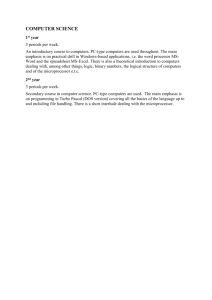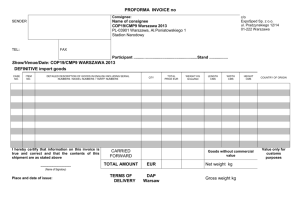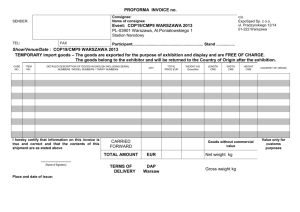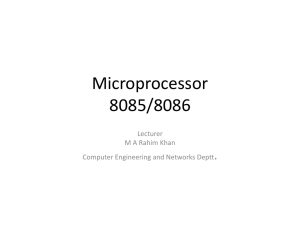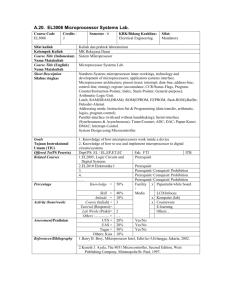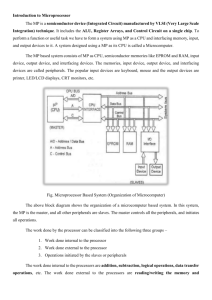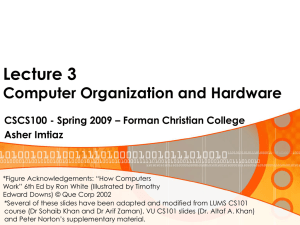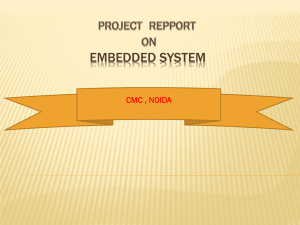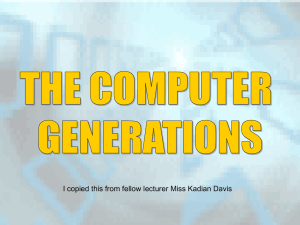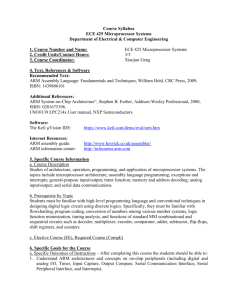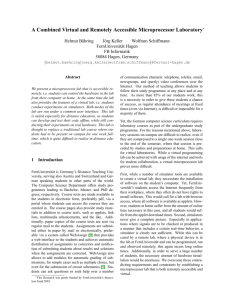Microprocessor engineering in medicine Course code: 6.9-WM
advertisement
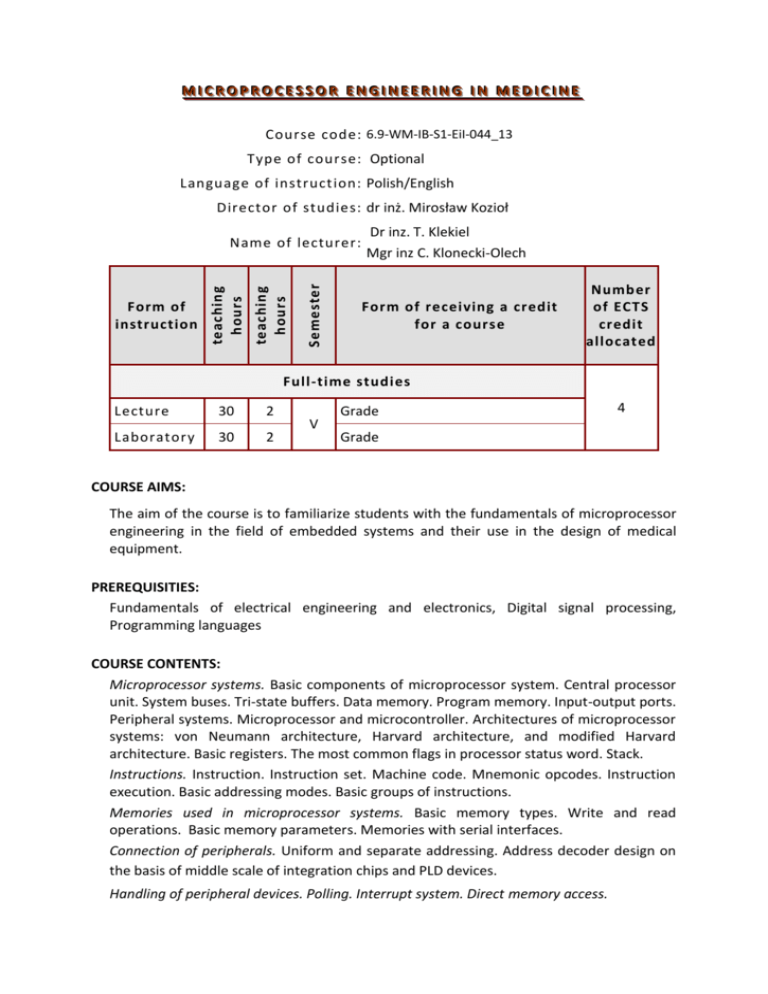
M MIICCRRO OPPRRO OCCEESSSSO ORR EENNGGIINNEEEERRIINNGG IINN M MEEDDIICCIINNEE Course code: 6.9-WM-IB-S1-EiI-044_13 Type of course: Optional Language of instruction: Polish/English Director of studies: dr inż. Mirosław Kozioł Form of instruction hours per semester Semester Number of teaching hours of Number perteaching semester Name of lecturer: Dr inz. T. Klekiel Mgr inz C. Klonecki-Olech Form of receiving a credit for a course Number of ECTS credit allocated Full-time studies Lecture 30 2 Laboratory 30 2 V Grade 4 Grade СOURSE AIMS: The aim of the course is to familiarize students with the fundamentals of microprocessor engineering in the field of embedded systems and their use in the design of medical equipment. PREREQUISITIES: Fundamentals of electrical engineering and electronics, Digital signal processing, Programming languages COURSE CONTENTS: Microprocessor systems. Basic components of microprocessor system. Central processor unit. System buses. Tri-state buffers. Data memory. Program memory. Input-output ports. Peripheral systems. Microprocessor and microcontroller. Architectures of microprocessor systems: von Neumann architecture, Harvard architecture, and modified Harvard architecture. Basic registers. The most common flags in processor status word. Stack. Instructions. Instruction. Instruction set. Machine code. Mnemonic opcodes. Instruction execution. Basic addressing modes. Basic groups of instructions. Memories used in microprocessor systems. Basic memory types. Write and read operations. Basic memory parameters. Memories with serial interfaces. Connection of peripherals. Uniform and separate addressing. Address decoder design on the basis of middle scale of integration chips and PLD devices. Handling of peripheral devices. Polling. Interrupt system. Direct memory access. Transmission of information transmission between microprocessor systems. Transmission of information with and without acknowledgement. Synchronous and asynchronous transmission. Parallel and serial transmission. Their advantages and disadvantages. Scope of application. The common standards of serial interfaces (RS-232C, RS-485). Microcontrollers of family MCS-51. The most significant features of their architecture. Functional blocks. Interfacing of external program and data memory. Available addressing modes. Embedded peripheral systems i.e. timer-counters and serial interface. Interrupts. Parallel ports. Power-saving modes of operation. Examples of programming in assembler and C. Basic user interface in microprocessor system. Keyboard. LED and LCD displays. Service of user interfaces by software. Microprocessor circuits in medical equipment. Examples of microprocessor-based medical devices: digital thermometer, oximeter, ECG, defibrillator, digital stethoscope, dialysis, respirator, infusion pump. Monitoring of the patient's vital signs - both wired and wireless solutions TEACHING METHODS: Education on this course is carried out by providing students the theoretical knowledge during the lecture and its practical application during the laboratory classes through the implementation of software for microprocessor systems. LEARNING OUTCOMES: In the field of technical sciences Knowledge, skills, competence K_W15 The student has an ordered knowledge of paradigm and programming techniques, knows recent trends and the latest achievements in the field of informatic applications dedicated to the Biomedical Engineering problems K_W19, K_W23 The student knows the basic methods, techniques and tools required to solve simple tasks in the field of Biomedical Engineering The student has a specialistic knowledge in the field of the chosen studies specialization K_U01 The student can obtain information from literature, databases and other sources, able to integrate the information, make their interpretation, as well as draw conclusions and formulate and opinions K_U05 The student can prepare, record and elaborate in written form issues of technical science and scientific disciplines specific to the field of Biomedical Engineering, in Polish and English K_K03 The student can interact and work in a group, adopting different roles LEARNING OUTCOMES VERIFICATION AND ASSESSMENT CRITERIA: The reference to the learning outcomes of the field of study K_W15, K_W19, K_W23 K_U01, K_U05, K_K03 The method of the learning outcomes assessment Grade To pass the lecture a positive grade of written test has to be get. Grade The laboratory grade results from testing how student was prepared for classes, execution of exercises, and written reports resulting from the execution of all exercises planed in the framework of laboratory. Lecture: Verification of learning outcomes is based on written tests carried out at least once a semester. To pass the lecture the student has to achieve positive grade of written tests. Laboratory: Verification of learning outcomes is based on written reports delivered to the teacher at the end of each laboratory exercise. The pass the laboratory the student has to achieve positive grades of all laboratory exercises planed to implementation in the framework of laboratory. STUDENT WORKLOAD: The student workload is 100 teaching hours (4 credits), including contact hours: 60 teaching hours, preparation for classes: 20 teaching hours, preparation of audit work, reports, etc.: 20 hours. RECOMENDED READING: 1. Hadam P., „Projektowanie systemów mikroprocesorowych”, BTC, Warszawa 2004. 2. Mielczarek W., „Szeregowe interfejsy cyfrowe”, Helion, Gliwice, 1993. 3. Pełka. R., „Mikrokontrolery: architektura, programowanie, zastosowania”, WKŁ, Warszawa, 2000. 4. Starecki T., „Mikrokontrolery 8051 w praktyce”, BTC, Warszawa 2002. OPTIONAL READING: 1. Badźmirowski K., Pieńkos J., Myzik I., Piotrowski A., „Układy i systemy mikroprocesorowe, cz.1 i 2”, WNT, Warszawa, 1990.Kadźmirowski K., Pieńkos J., Piestrzyński W., „Systemy mikroprocesorowe, WNT, Warszawa 1981.Bogusz J., „Programowanie mikrokontrolerów 8051 w języku C w praktyce”. BTC, Warszawa 2005.Majewski J. „Programowanie mikrokontrolerów 8051 w języku C, pierwsze kroki”, BTC, Warszawa 2005.
